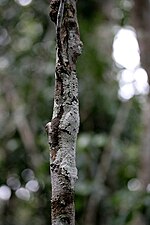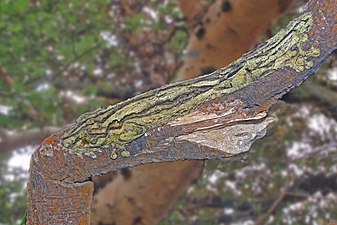Uroplatus sikorae
| Uroplatus sikorae | |
|---|---|

| |
| from Vohimana Reserve, Andasibe | |

| |
| from Montagne d'Ambre National Park both U. sikorae | |
| Scientific classification | |
| Domain: | Eukaryota |
| Kingdom: | Animalia |
| Phylum: | Chordata |
| Class: | Reptilia |
| Order: | Squamata |
| Family: | Gekkonidae |
| Genus: | Uroplatus |
| Species: | U. sikorae
|
| Binomial name | |
| Uroplatus sikorae (Boettger, 1913)
| |

| |
| Geographic range of U. sikorae in Madagascar | |
| Synonyms[2] | |
Uroplatus sikorae, commonly referred to as the mossy leaf-tailed gecko or the southern flat-tail gecko, is a species of lizard in the family Gekkonidae. The species is endemic to Madagascar. It is a CITES II protected animal due to habitat loss.
Etymology
The specific name, sikorae, is a Latinization of the surname of Franz Sikora, an Austrian fossil-hunter and explorer of Madagascar.[3]
Taxonomy
The species was first described by German
The genus Uroplatus contains 14 species endemic to
Phylogenically, U. sikorae has been placed within a monophyletic complex consisting of three other species of Uroplatus:
Distribution and habitat
Uroplatus sikorae is
Description
The mossy leaf-tailed gecko ranges in size from 15 to 20 centimetres (6 to 8 in) when measured from nose to base of the tail. Their eyes are large and lidless, and have yellow sclera with elliptical pupils, suited for the gecko's nocturnal habits. As with all Uroplatus geckos, the tail is dorso-ventrally flattened. U. sikorae has coloration developed as camouflage, most being grayish brown to black or greenish brown with various markings meant to resemble tree bark, down to the lichens and moss found on the bark.
U. sikorae has flaps of skin, running the length of its body, head and limbs, known as the dermal flap, which it can lay against the tree during the day, scattering shadows, and making its outline practically invisible.[10] Additionally, the gecko has a limited ability to alter its skin color to match its surroundings.[11]
-
Analamazaotra Forest Reserve, Anadasibe
-
unknown location, appears to be undescribed species/subspecies
-
hidden on branch, Montagne d’Ambre
-
revealing itself, Montagne d’Ambre
Biology and behavior
Mossy leaf-tailed geckos are
Captivity
The mossy leaf-tailed gecko is uncommon in captivity and often kept in breeding pairs or trios. They eat a variety of appropriately sized insects including crickets and moths. If breeding is successful in captivity, eggs will be laid every 30 days and take 90 days to hatch.
Threats
Habitat destruction and deforestation in Madagascar is the primary threat to this animal's future as well as collection for the pet trade.[12] The World Wide Fund for Nature (WWF) lists all of the Uroplatus species on their "Top ten most wanted species list" of animals threatened by illegal wildlife trade, because of them "being captured and sold at alarming rates for the international pet trade". It is a CITES Appendix 2 protected animal.[12]
References
- ^ . Retrieved 11 December 2022.
- ^ Uroplatus sikorae at the Reptarium.cz Reptile Database
- ISBN 978-1-4214-0135-5. (Uroplatus sikorae, p. 243).
- ^ Boettger O (1913). "Reptilien und Amphibien von Madagascar, den Inseln und dem Festland Ostafrikas ". pp. 269–375. In: Voeltzkow A (1913). Reise in Ostafrika in den Jahren 1903–1905. Wissenschaftliche Ergebnisse. Band III [Volume 3]. Systematische Arbeiten. Stuttgart: E. Schweizerbart'sche Verlagsbuchhandlung, Nägele & Dr. Sproesser. ("Uroplates [sic] sikorae", new species, pp. 294–295 + Plate 26, figure 2).
- ISBN 978-3929449037.
- S2CID 82263959.
- ^ a b c d Ratsoavina FM, Raminosoa NR, Louis EE Jr, Raselimanana AP, Glaw F, Vences M (2013). "An overview of Madagascar's leaf tailed geckos (genus Uroplatus): species boundaries, candidate species, and review of geographical distribution based on molecular data". Salamandra. 49 (3): 115–148.
- ^ .
- ^ ISBN 1-84162-029-7.
- ^ ISBN 0-520-24847-3.
- ^ Selim, Jocelyn (31 March 2005). "A Naturalist's Paradise". Discover Magazine. Retrieved 31 October 2008.
- ^ a b "Inclusion of Uroplatus spp. in Appendix II" (PDF). Technical comments in support of amendments to CITES appendices submitted by Madagascar. CITES. 2004. Archived from the original (PDF) on 23 November 2008. Retrieved 2 November 2008.
External links
 Media related to Uroplatus sikorae at Wikimedia Commons
Media related to Uroplatus sikorae at Wikimedia Commons





